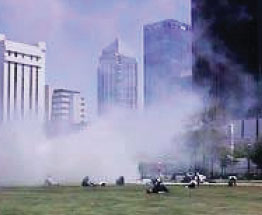
|
Indicators of a Possible Chemical
Incident Dead animals/birds/fish Not just an occasional incident, but numerous animals (wild and domestic, Lack of insect life Normal insect activity (ground, air, and/or water) missing, dead insects evident in the ground/water surface/shoreline Physical symptoms Numerous individuals experiencing unexplained water-like blisters, wheals (similar to bee stings), pinpointed pupils, choking, respiratory ailments and/or rashes Mass casualties Numerous individuals exhibiting unexplained serious health problems ranging from nausea to disorientation to difficulty in breathing to convulsions and death Definite pattern of casualties Casualties distributed in a pattern that may be associated with possible agent dissemination methods Illness associated with confined geographic area Lower incidence of symptoms for people working indoors than outdoors, or the reverse Unusual liquid droplets Numerous surfaces exhibiting oily droplets/film; numerous water surfaces displaying an oily film (no recent rain) Areas that look different in appearance Not just a patch of dead weeds, but trees, shrubs, bushes, food crops, and/or lawns that are dead, discolored, or withered (no current drought) Unexplained odors Smells ranging from fruity to flowery to sharp/pungent to garlic/horseradish-like to bitter almonds/peach kernels to newly mown hay; the particular odor is completely out of character with its surroundings Low-lying clouds Low-lying cloud/fog-like condition that is not explained by its surroundings Unusual metal debris Unexplained bomb/munitions-like material, especially if it contains a liquid (no recent rain)
A low-hanging cloud might be a sign of a chemical attack.
|
|

